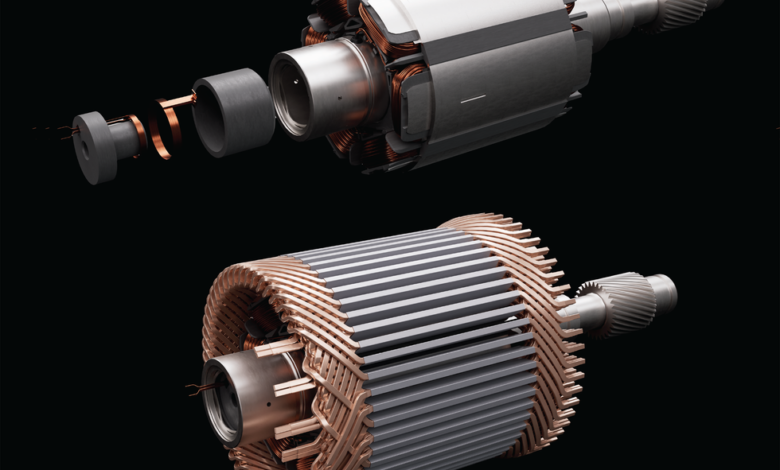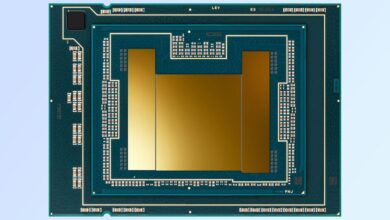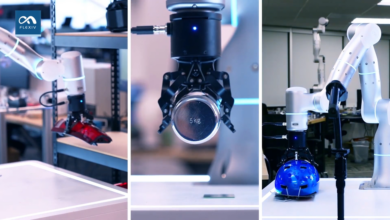How to Build EV Motors Without Rare Earth Elements

The dilemma is easy to describe. Global efforts to combat climate change hinge on pivoting sharply away from fossil fuels. To do that will require electrifying transportation, primarily by shifting from vehicles with combustion engines to ones with electric drive trains. Such a massive shift will inevitably mean far greater use of electric traction motors, nearly all of which rely on magnets that contain rare earth elements, which cause substantial environmental degradation when their ores are extracted and then processed into industrially useful forms. And for automakers outside of China, there is an additional deterrent: Roughly 90 percent of processed rare earth elements now come from China, so for these companies, increasing dependence on rare earths means growing vulnerability in critical supply chains.
Against this backdrop, massive efforts are underway to design and test advanced electric-vehicle (EV) motors that do not use rare earth elements (or use relatively little of them). Government agencies, companies, and universities are working on this challenge, oftentimes in collaborative efforts, in virtually all industrialized countries. In the United States, these initiatives include long-standing efforts at the country’s national laboratories to develop permanent magnets and motor designs that do not use rare earth elements. Also, in a collaboration announced last November,
General Motors and Stellantis are working with a startup company, Niron Magnetics, to develop EV motors based on Niron’s rare earth–free permanent magnet. Another automaker, Tesla, shocked observers in March of last year when a senior official declared that the company’s “next drive unit,” which would be based on a permanent magnet, would nevertheless use no “rare earth elements at all.” In Europe, a consortium called Passenger includes 20 partners from industry and academia working on rare earth–free permanent magnets for EVs.
We have been working for nearly a decade on magnetic and other aspects of traction-motor design at
Oak Ridge National Laboratory (ORNL), in Tennessee, a hub of U.S. research on advanced motors for EVs. Along with colleagues from the National Renewable Energy Laboratory, Ames Laboratory, and the University of Wisconsin, Madison, we have been studying advanced motor concepts as part of the U.S. Department of Energy’s U.S. Drive Technologies Consortium. The group also includes Sandia National Laboratories, Purdue University, and the Illinois Institute of Technology.
With all of this activity, you would think that engineers would have by now developed a sophisticated understanding of what is possible with rare earth–free electric motors. And indeed they have. We and other researchers are evaluating promising permanent-magnet materials that don’t use rare earth elements, and we are evaluating possible motor-design changes required to best use these materials. We are also evaluating advanced motor designs that do not use permanent magnets at all. The bottom line is that replacing rare earth–based magnets with non–rare earth ones comes at a cost: degraded motor performance. But innovations in design, manufacturing, and materials will be able to offset—maybe even entirely—this gap in performance. Already, there are a few reports of tantalizing results with innovative new motors whose performance is said to be on a par with the best permanent-magnet synchronous motors.
Why rare earths make the most powerful electric motors
Rare earth elements (which people in our line of work often refer to as REEs) have unique properties that make them indispensable to many forms of modern technology. Some of these elements, such as neodymium, samarium, dysprosium, and terbium, can be combined with ferromagnetic elements such as iron and cobalt to produce crystals that are not only highly magnetic but also strongly resist demagnetization. The metric typically used to gauge these important qualities of a magnet is called the
maximum energy product, measured in megagauss-oersteds (MGOe). The strongest and most commercially successful permanent magnets yet invented, neodymium iron boron, have energy products in the range of 30 to 55 MGOe.
For an electric motor based on permanent magnets, the stronger its magnets, the more efficient, compact, and lightweight the motor can be. So the highest-performing EV motors today all use neodymium iron boron magnets. Nevertheless, clever motor design can reduce the performance gap between motors based on rare earth permanent magnets and ones based on other types of magnets. To understand how, you need to know a little more about electric motors.
The most common type of traction motor in electric vehicles is the interior-mount permanent-magnet synchronous motor. Permanent magnets inside the rotor interact with a rotating magnetic field created by electromagnet windings in the stator, which surrounds the rotor.Oak Ridge National Laboratory
There are two basic types of electric motors: synchronous and induction. Most modern electric vehicles use a type of synchronous motor that has a rotor equipped with permanent magnets. Induction motors use only electromagnets and are therefore inherently rare earth–free. But they are not used today in most EV models because their performance is generally not on a par with permanent-magnet synchronous motors, although several R&D projects in the United States, Europe, and Asia are trying to improve induction motors.
The term “synchronous motors” refers to the fact that the rotor of the motor (the part that turns) rotates in synchrony with the changing magnetic fields produced by the stator (the part that remains stationary). In the rotor, permanent magnets are embedded in a circle around the structure. In the stator, also in a circular arrangement, electromagnets are pulsed with electricity one after another to set up a rotating magnetic field. This process causes the rotor magnets and stator magnets to attract and repel one another sequentially, producing rotation and torque.
Synchronous motors, too, fall into several categories. Two important types are
surface-mount permanent-magnet synchronous motors and synchronous reluctance motors. In the former group, permanent magnets are mounted on the external surface of the rotor, and torque is produced because different parts of the stator and rotor either attract or repel. In a synchronous reluctance motor, on the other hand, the rotor doesn’t need to have permanent magnets at all. What makes the motor spin is a phenomenon called magnetic reluctance, which refers to how much a material opposes magnetic flux passing through it. Ferromagnetic materials have low values of reluctance and will tend to align themselves with strong magnetic fields. This phenomenon is exploited to cause a ferromagnetic rotor, in a reluctance motor, to spin. (Some reluctance motors also employ permanent magnets to assist that rotation.)
If a motor depends mainly on the interaction between the stator and rotor magnetic fields, it is called a permanent-magnet
dominated motor. If on the other hand it depends on the torque produced by differences in reluctance, it is a permanent-magnet assisted motor. The combined use of both types of torque—that produced by the attraction and repulsion of permanent magnets and that produced by the tendency of magnetic lines of force to flow along a path of least reluctance—is the key strategy being used by engineers striving to achieve high performance in a motor that is less reliant on REE magnets.
Replacing REE-based magnets with non-REE ones comes at a cost: degraded motor performance. But innovations in motor design, manufacturing, and materials will be able to offset—maybe even entirely—this gap in performance.
The most common motor type at the moment combining the two kinds of torque is the
interior-mount permanent-magnet motor, in which the permanent magnets embedded within the rotor add to the reluctance torque. Many commercial EV manufacturers, including GM, Tesla, and Toyota, now use this type of rotor design.
The design of the motors for the Toyota Prius underscores the effectiveness of this approach. In these motors, the magnet mass decreased significantly over a period of 13 years, from 1.2 kilograms in the 2004 Prius to about 0.5 kg in the 2017 Prius. Much the same occurred with the Chevrolet Bolt motor, which reduced the overall usage of magnet material by 30 percent compared with the motor in its predecessor, the Chevrolet Spark.
Wringing the most out of permanent magnets without rare earths
But what about getting rid of REEs entirely? Here, there are two possibilities: Use REE-free permanent magnets in a motor designed to make the most of them, or use a motor that dispenses with permanent magnets entirely, in favor of electromagnets.
To understand the suitability of a particular REE-free permanent magnet for use in a powerful traction motor, you have to consider a couple of additional characteristics of a permanent magnet: remanence and coercivity. To begin with, recall the metric used to compare the strength of different permanent-magnet materials: maximum energy product. These three parameters—maximum energy product, remanence, and coercivity—largely indicate how well a permanent-magnet material will perform in an electric motor.
Remanence indicates the amount of magnetic intensity, as measured by the density of the lines of force, left in a permanent magnet after the magnetic field that magnetized this magnet is withdrawn. Remanence is important because without it you wouldn’t have a permanent magnet. And the higher the remanence of the material, the stronger the forces of magnetic attraction and repulsion that create torque.
The coercivity of a permanent magnet is a measure of its ability to resist demagnetization. The higher the value of coercivity, the harder it is to demagnetize the magnet with an external magnetic field. For an EV traction motor, an optimal permanent magnet, such as neodymium iron boron, has high maximum energy product, high remanence, and high coercivity. No REE-free permanent magnet has all of these characteristics. So if you replace neodymium iron boron magnets with, say, ferrite magnets in a motor, you can expect a decrease in torque output and also must accept a greater risk that the magnets will demagnetize during operation.
An experimental motor built by the authors at Oak Ridge National Laboratory did not use any heavy rare earth elements. Neodymium iron boron permanent magnets are mounted on the external surface of the rotor. These magnets are represented by the teal-colored ring of blocks surrounding the copper-colored stator windings. To save space, the motor’s inverter and control electronics were installed inside the stator.Oak Ridge National Laboratory
Motor engineers can minimize the difference by designing a motor that exploits both permanent magnets and reluctance. But even with a highly optimized design, a motor based on ferrite magnets will be considerably heavier—perhaps a third or more—if it is to achieve the same performance as a motor with rare earth magnets.
One technique used to wring maximum performance out of ferrite magnets is to concentrate the flux from those magnets to the maximum extent possible. It’s analogous to passing moving water through a funnel: The water moves faster in the narrow opening. Researchers have built such machines, called spoke-ferrite magnet motors, but have found them to be about
30 percent heavier than comparable motors based on REE magnets. And there’s more bad news: Spoke-type motors can be complex to manufacture and pose mechanical challenges.
Some designers have proposed using another kind of non-REE magnet, one made from an aluminum nickel cobalt alloy called alnico, commonly used in the magnets that hold refrigerator doors shut. Although alnico magnets have high remanence, their coercivity is quite low, making them prone to demagnetization.
To address this issue, several researchers have studied and designed
variable-flux memory motors, which use a magnetizing component of current to aid in torque production, in effect keeping the magnets from demagnetizing during operation. Additionally, researchers from the Ames Laboratory have shown that alnico magnets can have increased coercivity while maintaining their high remanence.
Three parameters—maximum energy product, remanence, and coercivity—largely indicate how a permanent magnet material will perform in an electric motor.
Lately, there’s been a lot of attention focused on a new type of permanent-magnet material, iron nitride (FeN). This magnet, produced by Niron Magnetics, has high remanence, equivalent to that of REE-magnets, but like alnico has low coercivity—
about a fifth of a comparable neodymium iron boron magnet. Because of these fundamentally different properties, FeN magnets require the development of new rotor designs, which will probably resemble those of past alnico motors. Niron is now developing such designs with automotive partners, including General Motors.
Yet another REE-free permanent-magnet material that comes up in discussions of future motors is manganese bismuth (MnBi), which has been the
subject of collaborative research at the University of Pittsburgh, Iowa State University, and Powdermet Inc. Together these engineers designed a surface-mount permanent-magnet synchronous motor using MnBi magnets. The remanence and coercivity of these magnets is higher than ferrite magnets but lower than neodymium iron boron (NdFeB). The researchers found that a MnBi-magnet motor can produce the same torque output as a NdFeB-magnet motor but with substantial compromises: a whopping 60 percent increase in volume and a 65 percent increase in weight. On the bright side, the researchers suggested that replacing NdFeB magnets with MnBi magnets could reduce the overall cost of the motor by 32 percent.
Another strategy for reducing rare earth content in motors involves eliminating just the heavy rare earth elements used in some of these magnets. NdFeB magnets, for example, typically contain small amounts of the heavy rare earth element dysprosium, used to increase their coercivity at high temperatures. (Heavy rare earth metals are generally in shorter supply than the light rare earths, such as neodymium.) The rub with not using them is that high-temperature coercivity then suffers.
So the major challenge in designing this kind of motor is keeping the rotor cool. Last year, at Oak Ridge National Laboratory,
we developed a 100-kilowatt traction motor that uses no heavy rare earth elements in its magnets. Another nice feature is that its power electronics are integrated inside of it. These power electronics included the inverter, which takes direct-current power from the battery and feeds the motor with alternating current at the proper frequency to drive the machine.
We faced several fundamental challenges in keeping the magnets from getting too hot. You see, permanent magnets are good conductors. And when an electrical conductor moves in a magnetic field, which is what rotor magnets do while the motor is operating, currents are induced in it. These currents, which do not contribute to the torque, heat up the magnets and can demagnetize them. One way to reduce this heating is to break up the path of the circulating currents by making the magnets from thin segments that are electrically insulated from one another. In our motor, each of these segments was only 1 millimeter thick.
We chose to use a grade of NdFeB magnets called N50 that can operate at temperatures up to 80 °C. Also, we needed to use a carbon-fiber-and-epoxy system to reinforce the outer diameter of the rotor to let it spin at speeds as high as 20,000 rpm. After analyzing our motor prototype, we discovered it would be necessary to force air through the motor to reduce its temperature when operating at maximum speed. While that’s not ideal, it’s a reasonable compromise to avoid having to use heavy REEs in the design.
New approaches for advanced motors
Perhaps the most attractive near-term option to make powerful motors that lack REEs entirely is to build synchronous motors that have rotors equipped with electromagnets (meaning coils of wire), either with or without ferrite magnets included with them. But doing that requires that you somehow pass electrical current to those spinning coils.
The traditional solution is to use carbon brushes to make electrical contact with spinning metal rings, called slip rings. This technique allows you to apply direct current to the rotor to energize its electromagnets. Those brushes produce dust, though, and eventually wear out, so these motors aren’t suitable for use in EVs.
To address this issue, engineers have devised what are called
rotary transformers or exciters. They employ an inductive or capacitive system to transfer power wirelessly to the spinning rotor. These motors have a great advantage over conventional, permanent-magnet synchronous motors, which is that their rotor’s magnetic field can be precisely adjusted, simply by controlling the current to the rotor’s electromagnets. That in turn permits a technique called field weakening, which allows high efficiency to be maintained through a wide range of operating speeds.
In the way they produce torque, synchronous electric motor types can be thought of as existing on a continuum between two different extremes. At the upper left in this chart is the surface permanent-magnet motor, which produces torque solely from the interaction between permanent magnets in the rotor and electromagnets in the stator. At the lower right is the synchronous reluctance motor, which creates torque by exploiting an entirely different phenomenon—magnetic reluctance, which refers to how much a material opposes magnetic flux passing through it. Most motor designs maximize torque by combining these two kinds of torque.Oak Ridge National Laboratory
A notable recent example is a motor built by the automotive supplier ZF Group. Last year the company announced it had produced a synchronous motor in which electromagnets in the rotor are powered by an inductive system that fits inside the machine’s rotor shaft. The 220-kW motor has power-density and efficiency characteristics on a par with those of the NdFeB permanent-magnet motors now used in EVs,
according to a company official.
New materials can also help bridge the gap between REE-magnet and non-REE-magnet motors. For example, high-silicon steel, renowned for its superior magnetic properties, emerges as a promising candidate for rotor construction, offering the potential to improve the magnetic efficiency of REE-free motors. Concurrently, using
high-conductivity copper alloys or ultraconducting copper strands can greatly reduce electrical losses and improve overall performance. Doubling the conductivity of copper, for example, could reduce the volume of certain motors by 30 percent. The strategic integration of such materials could dramatically narrow the performance gap between REE-containing and REE-free motors.
Another good example of an advanced material that could make a big difference is a
dual-phase magnetic material developed by GE Aerospace, which can be magnetized either very strongly or not at all in specified areas. By selectively making certain sections of the rotor nonmagnetic, the GE Aerospace team demonstrated that it is possible to eliminate virtually all magnetic leakage, which in turn allowed them to forgo using rare earth permanent magnets in the motor.
How engineers will navigate the transition to REE-free motors
The transition toward rare earth–free motors for EVs is a major and pivotal engineering endeavor. It will be difficult, but research is beginning to yield intriguing and encouraging results. There will soon be multiple designs available—with, alas, a complex array of trade-offs. Motor weight, power density, cost, manufacturability, and overall performance dynamics will all be important considerations. And success in the marketplace will no doubt depend on an equally complex set of economic factors, so it’s very hard to predict which designs will dominate.
What’s becoming clear, though, is that it’s perfectly feasible that REE-free motors will one day become mainstream. That outcome will require continued and concerted effort. But we see no reason why engineers can’t navigate the complexities of this transition, ensuring that the next generation of EVs is more environmentally benign. Already, at ORNL and elsewhere, AI-enabled motor-design tools are accelerating the development of these REE-free motors.
Today, the large-scale use of REE magnets is marked by arguments pitting technological benefits against environmental and ethical considerations. Soon, those arguments could be much less relevant.
We’re not there yet. As with any major technological transition, the journey to rare earth–free motors won’t be short or straight. But it will be a journey well worth taking.
IEEE Spectrum




